Introduction
Abundant harvest and the MMA (minimum market access) import volume from abroad have created a surplus of rice in Korea. Methods to economically extend the storage life of rice without seriously sacrificing the rice quality, including weight loss, cooking quality are attracting more attentions (Kwon, 1984; Kwon, 1987; Kwon, 1989). Storage of rice in the form of brown rice is becoming attractive with the advance of storage facilities in Korea.
Rice is commonly divided into paddy (uncleaned)-, brown (dehulled)-, and milled (debranned) rice (Delcour & Hoseney, 2010). Paddy rice is the traditional storage form of rice in Korea (Shin et al., 1991). For consumption, paddy rice that has been stored after the autumn harvest under reasonably optimum conditions during the winter season is dehulled, polished, and prepared for sale on demand. Throughout storage, paddy is more excellent against harmful insect than brown and milled rices. Recently, interest in low temperature storage has increased in Korea (Kwon, 1987; Kwon, 1989) to reduce rice deterioration. Theoretically, paddy rice is better than brown and milled rices for long storage, but disadvantage also includes increased occupation and shipping volume due to the useless hulls attached to the rice kernel during storage and distribution of paddy rice (Perdon et al., 1997). In contrast, dehulled brown rice requires less than half the space for storage, packaging, and transportation.
In Japan, where low temperature storage facilities are common, more than 45% of rice is stored in the form of brown rice. However, brown rice has a shorter shelf-life (Cho & Kim, 1990; Han et al., 1996). The naturally-existing enzyme lipase in the brown rice causes the oil to become rancid. The increased loss of internal moisture content or the brown rice kernel during storage also leads to low palatability of the cooked rice (Siebenmorgen & Meullenet, 2004).
Rice storage at ambient temperature is commonly practiced during the colder winter period that follows the harvest season (Chrastil, 1990a). However, for effective quality control of stored brown rice under Korean weather conditions, detailed studies regarding the quality characteristics of stored brown rice are needed. The purpose of this study was to measure changes in typical quality attributes of brown rice during storage resulting from the combined effects of initial moisture content of the kernel, storage temperature, and packaging. Using the same batch of rice harvested from the same paddy area, changes in brown rice quality during a storage period of sixteen weeks under different conditions were investigated.
Materials and Methods
Paddy rice (Choochung variety), harvested in the Pyeongtaek District of Kyonggi-do Province with an initial moisture content of 21% was dried under a grain dryer (HSD-44FM, Hansung Industrial Co., Ltd., Seoul, Korea) to a final moisture content of approximately 18%. Natural drying followed at room temperature to equilibrate final kernel moisture content values of approximately 15, 16, and 17%. To obtain brown rice, the paddy rice was dehulled using desktop husker (SYTH-88, Ssangyong Machinery Industry Co., Inchon, Korea).
Brown rice, packed in laminated LDPE/OPP plastic film bags (29×41 cm) and craft-paper bags (30×50 cm) was stored in three temperature-controlled chambers (IB-450M, JEIO TECH., Seoul, Korea) at 10, 15, and 20℃ for 16 weeks. The moisture content, the weight (‘100-kernel weight’ basis), and fat acidity of the rice kernel were checked weekly. The humidity of the chambers was not regulated.
A ‘10 g kernel-135℃-24 h method’ was used to obtain data. Results were converted to a moisture content based upon ‘5 g kernel-105℃ standard method’ (Jung, 2002). Final results were expressed on an ‘as is’ basis. All analyses were performed using at least triplicate samples.
A total of 100 randomly selected kernels was weighed using an electronic balance (GT4800, OHAUS Co., Pine Brook, NJ, USA). Weights were expressed on a ‘100-kernel weight’ basis.
An ‘AACC approved method’ (AACC, 1995) was used for measurement of fat acidity. Samples were prepared by grinding approximately 20 g of each rice kernel in a hammer mill (Micro Hammer Mill, Cullatti Ag, Zurich, Switzerland) using a 0.1 mm screen at the maximum speed. Each ground samples was extracted using 100 mL of petroleum ether (reagent grade, Duksan Chemical Co., Seoul, Korea) at room temperature for 10 min with intermittent shaking by hands. Care was taken to prevent the oxidation of fats after grinding by using rapid application of the petroleum ether. The samples were filtered through a Whatman No. 2 filter paper (Whatman International Ltd, Maidstone, Kent, UK) to obtain a 50 mL sample extract. Petroleum ether was vaporized away using a rotary evaporator (RE III, BÜCHI Labortechnik AG, Flawil, Switzerland) and the oil residue was added to a 50 mL of BAP (Benzene Alcohol Phenolphthalen) solution. The sample solution was titrated with 0.0178 N KOH until a faint pink color persisted for one min. The free fatty acid content was calculated as follows.
Here, T : mL, 0.0017 N KOH solution for the titration
B : mL, 0.0017 N KOH solution for the blank titration
W : g, moisture content for 100 g-sample
Results and Discussion
Figs. 1-3 show the changes in moisture content of brown rice kernels during storage for 16 weeks being related to different packaging materials (craft paper and plastic film), storage temperature (10, 15, and 20℃), and the adjusted initial moisture content of the kernel at 15% (Fig. 1), 16% (Fig. 2), and 17% (Fig. 3).

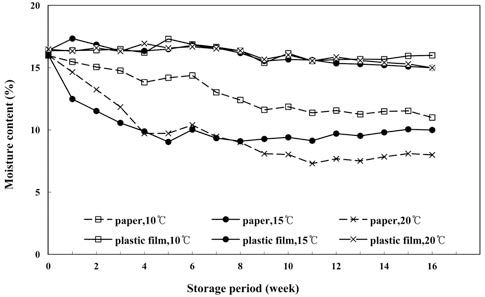

The final moisture content of the rice kernel at the end of storage showed a wide variation according to the storage conditions. With an initial moisture content of 16% (Fig. 2), the moisture were 8.1% (20℃, paper), 10.1% (15℃, paper), 11.5% (10℃, paper), 15.1% (15℃, plastic), 15.3% (20℃, plastic), and 16.0% (10℃, plastic), respectively. The retention rates of the original moisture content (0-day storage) after sixteen weeks of the storage are shown in Table 1.
| Moisture content, % | Craft paper | Plastic film | ||||
|---|---|---|---|---|---|---|
|
|
|
|||||
| 10°C | 15°C | 20°C | 10°C | 15°C | 20°C | |
| 15 | 76.9 | 65.8 | 53.8 | 97.7 | 98.3 | 92.7 |
| 16 | 72.2 | 62.8 | 50.7 | 94.3 | 92.1 | 91.2 |
| 17 | 67.9 | 59.9 | 48.4 | 92.6 | 88.6 | 87.9 |
Plastic film packaging was effective for the prevention of moisture loss of the kernel during storage. Increases in moisture loss from paper packaging from the start of storage occurred as the storage temperature increased. A slight decrease in kernel moisture appeared after nine weeks of storage, although the tendency was very small (Figs. 1-3). A storage temperature of 20℃ caused comparably steeper decline afterwards. Higher moisture losses were noted as the initial moisture content of the kernel increased. More than 92% of the moisture content was retained with plastic film packaging under all storage conditions when the initial moisture content of the kernel did not exceed 16% (Table 1). A high equilibrium relative humidity (ERH) in the head space of the plastic bags probably caused continued adsorption and desorption of moisture under storage conditions, according to the hygroscopic property of the rice, thus maintaining the initial moisture of the kernel. The initial moisture content of the kernel was better maintained with deceasing storage temperature (10℃ > 15℃ > 20℃) and an increasing initial moisture content (17% > 16% > 15%).
Paper packaging results were significantly different from those of plastic packaging (Figs.1-3). A gradual and incessant loss of moisture occurred from the rice kernel under all treatment conditions of storage temperature and initial moisture content. A high storage temperature accelerated moisture loss from the rice kernel. Although a decrease in moisture content occurred throughout the storage period, the majority of weight loss occurred during the first three to four weeks of storage. A lower storage temperature of lower than 15℃ was thought to be necessary to reduce the moisture loss with paper packaging. It is particularly noteworthy that loss of moisture was almost stagnant after five weeks of storage at 15℃ under all conditions (Figs. 1-3). A continued decrease in kernel moisture up to week 9 followed by a slow down or stabilization in moisture content up to week 16 was observed during storage. The occurrence of turnover in moisture contents of the kernel stored at 15℃ and 20℃ in paper bags after week 7 (Fig. 1) was undefined at this time. As much as half of the initial moisture content was lost at the end of storage at 20℃ (Table 1). The excessive loss of moisture from the rice could cause the kernel to crack under mechanical stress (Kunze & Choudhury, 1972; Kunze, 1983). These cracks promote insect attack, increase enzyme reactions, and resultant deterioration of the rice value, due to poor taste, a poor external appearance after cooking, and changes in the texture (Kwon, 1989; Shin et al., 1991; Jean-Francois et al., 1999; Siebenmorgen & Meullenet, 2004). Thus, maintenance of constant moisture content is important. In this point of view, the paper bag containers are not adequate for the quality preservation of brown rice.
Figs. 4-6 show weight changes of brown rice kernels during storage. The general pattern mimics changes in the moisture content, signifying the relationship between weight change and moisture content. With paper packaging, loss of kernel weight increased under all conditions with an increase in storage temperature. 5
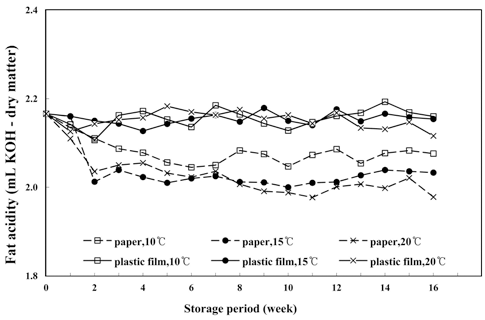


Plastic film packaging was far more effective than paper for the preservation of the kernel weight during storage. With paper, the fast initial drop in weight followed by a slow down or stabilization in weight loss was observed again after four to six weeks. The occurrence of turnover in the decreasing rates between storage temperatures of 15℃ and 20℃ was verified by measurement of the moisture content.
The retention rate of the kernel weight at the end of storage vs. the original weight is shown in Table 2. Variations in the retention rate were less than variations as caused by moisture changes due to limitation in the total moisture content (15- 17%) of the kernel.
| Moisture content, % | Craft paper | Plastic film | ||||
|---|---|---|---|---|---|---|
|
|
|
|||||
| 10°C | 15°C | 20°C | 10°C | 15°C | 20°C | |
| 15 | 96.2 | 94.0 | 93.3 | 99.6 | 99.0 | 99.1 |
| 16 | 94.9 | 92.6 | 91.4 | 99.0 | 98.7 | 97.6 |
| 17 | 93.3 | 92.5 | 91.0 | 97.4 | 97.2 | 96.1 |
In addition, kernel weight loss might be influenced by postharvest metabolism of the grain, including respiration and, enzyme activity (Chrastil, 1990b). In this analysis, even the worst case, weight retention was more than 91% during the entire storage period of sixteen weeks (Table 2). The initial weight of the kernel was maintained better under lower storage temperature (10℃ > 15℃ >20℃) and a lower initial moisture content (15% > 16% > 17%). The higher moisture contents of the kernel might have been more favored by the metabolic respiration and enzyme activity of the kernel tissues which led to increased weight losses as stated above (Chrastil, 1990b) and by the chances of water evaporation although its effect is rather limited.
Storage at cool temperatures has been reported to slow deterioration in brown rice and extends its shelf life (Mitsuca et al., 1972; Dupuy, 1980). Free fatty acid values increased throughout storage, especially with plastic–film packaging, high storage temperatures, and a high initial moisture content of the kernel.
The storage of brown rice in plastic packaging caused sharp and serious increases in peroxide values from the start of storage with higher moisture contents and storage temperatures (Figs. 7-9). For example, brown rice with initial moisture contents of 15% (Fig. 7) and 16% (Fig. 8) in plastic packaging required only eight to ten weeks for the free fatty acid content to reach 20 mg KOH/100 g. This is commonly considered to be the maximum value for acceptable palatability (Jung, 2002). With an initial moisture content of 17%, only two weeks (at 20℃, Fig. 9) and three weeks (at 10℃ and 15℃, Fig. 9) were required to reach this boundary value. This limit could be greater or lesser depending on the milling ratio if the outer bran part, where most of the fat oxidation takes place (Orthoefer & Eastman, 2004), is removed from whole kernel throughout ‘polishing’ to white rice before final consumption. Moisture in the kernel greater than a level of 17% was detrimental to the preservation of brown rice when plastic packaging was used. The presence of water which is essential for the activity of lipase greatly increases the oxidation of fatty acids (Sowbhagya & Bhattacharya, 1976), especially under high temperatures. Mechanical processing, such as dehulling, can rupture the cell walls that surround oil spherosomes (Godber & Juliano, 2004; Aibara et al., 1986) and expose the rice kernel to lipase. The oil becomes oxidized and rancid in only a few hours.
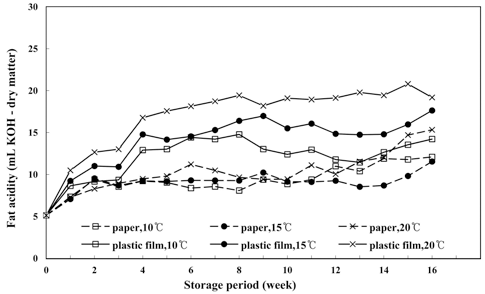
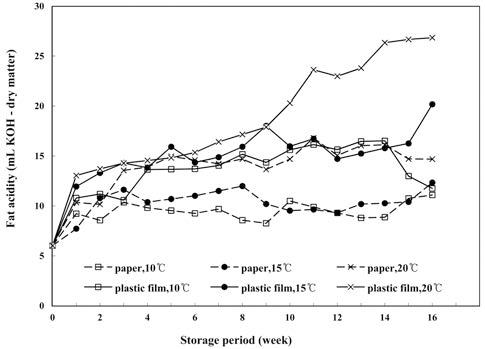
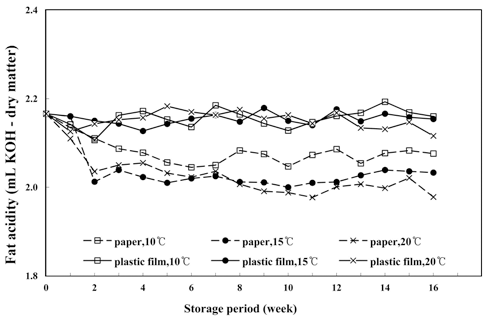
Fat oxidation values for the kernel with paper packaging were stagnant after reaching a maximum on week 7 under all temperatures, although an increase was noted at the end of storage.
Conclusion and future perspectives
Craft-paper packaging was not adequate for the quality preservation of brown rice in relation to the preservation of the initial moisture level of the kernel. Plastic-film packaging showed excellent maintenance of an adequate moisture level for the kernel, however, oxidation of the rice kernel with a high moisture content (17%) and/or a relatively high storage temperature (20℃) was observed. The optimum storage conditions for maintaining the quality of brown rice are: an initial moisture content of 16%, plastic-film packaging, and a storage temperature of 15℃ or less. Evaluation of the fat acidity content in milled rice after polishing from brown rice after storage and sensory and textural quality evaluations of the final cooked rice product is supposed to be undertaken in the future.







